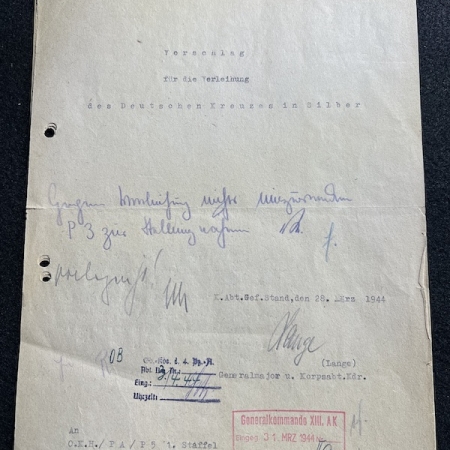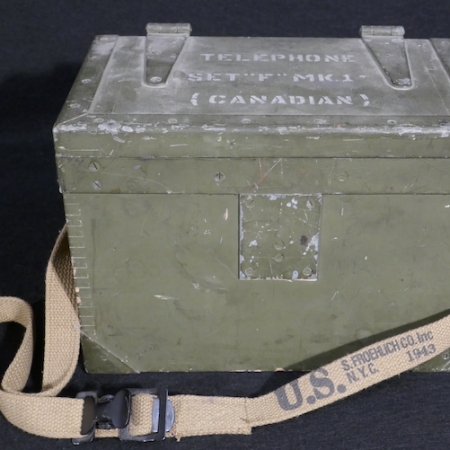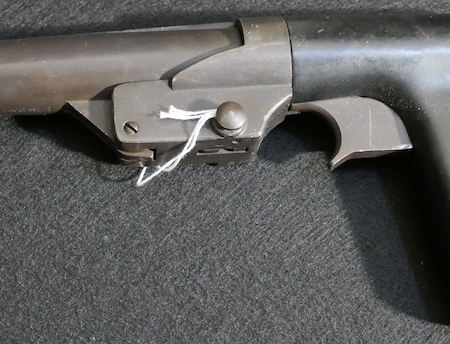Showing 298–306 of 1325 resultsSorted by latest
-

WWII German Wehrmacht Soldbuch – Hauptmann Gehrke – 246 Volksgrenadier Division – Aachen – Iron Cross First Class Aachen Battles against US Troops – Captured Rare
$485.00The pay book belonged to customs inspector Richard Gehrke, who was born in 1904, and was issued on January 26, 1943 by the Grenadier Replacement Battalion 110. Interestingly, it bears the number 1. At this time Gehrke was a first lieutenant in the reserve. The Gren.Ers.Btl. represented the replacement for the 79th Infantry Division, which was on the Eastern Front at the time, so that Gehrke’s presumably first deployment to the front took him to the 886 Grenadier Regiment of this very division. During his deployment on the Eastern Front, he contracted typhoid fever in September 1943, which kept him busy for a good two months, led him to various hospitals and finally to the Truscawiecz army convalescent home (presumably located in Poland). However, the infection seems to have healed without any consequences and Gehrke returned to his troops, because on February 4, 1944 he was awarded the EK2 by the 79th ID. He also changed units within the division at an unspecified point in time and was deployed to Grenadier Regiment 212 for a while (coming from Grenadier Replacement Battalion 212). At the end of April 1944, Gehrke was admitted to a hospital with an injury that he must have sustained in an accident (code 34). On July 1, 1944, Gehrke was promoted to captain in the reserve, and here an inconsistency occurs: The promotion was carried out by the unit with the field post number 23353 (if I deciphered the number correctly), which is assigned to the field replacement battalion 246. However, this unit does not appear on page 4 as a replacement unit, especially since the 246th ID no longer existed at that point. However, I can’t imagine that this could be a coincidence or wrong. Perhaps he was briefly intended for the division’s re-formation as the 246th VGD? Be that as it may, his stay with the 149th Staff and Grenadier Regiment of the 49th Infantry Division is assured. This division was a ground-based, non-mobile unit in the Boulogne area and did NOT take part in the fighting there after the landing in Normandy. Instead, it withdrew to the area west of Paris and had initial enemy contact in the defense of the Seine crossings. The bulk of the division was captured in the Mons pocket. Gehrke was not one of them; he appears to have been one of only around 1,500 men to escape the cauldron. With regular enemy contact, the division withdrew further towards Reich territory via Belgium and Holland and crossed the border at Aachen. At the end of September, on the eve of the 2nd Battle of Aachen, the division was reorganized and fresh troops were added to it. On October 1st it had a combat strength of around 5,100 men (9,400 total) and was fighting on the northern edge of Aachen (Alsdorf, Merkstein, Palenberg, Kohlscheid for those who know their way around) against the American 29th US Infantry -Division. Gehrkte probably experienced these fights first hand. At Aachen the division was again almost completely wiped out. It lost so much of its fighting strength that it virtually ceased to exist and on October 23rd the pitiful remnants were incorporated into the 246th VGD, which had also been badly beaten near Aachen, on the arbitrary orders of Field Marshal Models. Gehrke’s unit, the Grenadier Regiment 149, was probably incorporated into the Grenadier Regiment 689. Once again, as in Mons, Gehrke must have been one of the few in his unit who survived the Aachen disaster and were not taken prisoner, because on November 19th the 246th VGD awarded him the EK1. At this point the 246th VGD was standing. in the defensive battle east of Aachen an der Rur. The EK1 is the last official entry, but the prisoner of war number written in bold on page 1 proves that Gehrke also survived the later fighting and was taken prisoner either in the North or Schnee Eifel (the division was for a short time in the Monschau area next to the 272nd VGD was deployed, but was later relocated to the area west of Stadtkyll to strengthen the former Ardennes Front). Removed from Consignment
-

WW2 German Wehrmacht General Wolfgang Lange – German Cross in Silver – Vorschlag – Hauptmann Otto Krause – Korps Abteilung C – Rare
$275.00An original typed German Cross in Silver Vorschlag – this was a process of nomination and display of evidence in order to get the award. The officer put forward is : Hauptmann Otto Krause – Unit is the Korpsabt C With the unit it seems Krause had mustered civilian labour in order to make straw shoes for 4500 Soldiers, and more Winter kit, as well as potatoes and even the material needed to make the small stoves in the bunkers work. Krause also fought off Partisans in order to get the supplies to where they were needed. Corps Department C was set up on November 2, 1943 in Army Group South by Military District XIII with replacement by Budweis as a new type of division. The remnants of the 183rd, 217th and parts of the 339th Infantry Division were used for this purpose. The staff was the former staff of the 183rd Infantry Division. The subordinate regiments and battalions retained their original names. It was placed under the 4th Panzer Army in Army Group South and deployed on the Eastern Front in the Kiev and Zhitomir areas. From January 1944, Corps Department C fought in the Hube Pocket, was trapped there and was able to free itself by March 1944. In April 1944 she joined Army Group Northern Ukraine in the area around Brody with the 4th Panzer Army. From July 1944, Corps Department C was with the 1st Panzer Army. From July 18, 1944, Corps Department C was trapped in the Brody Pocket and subsequently destroyed. On July 27, 1944, Corps Department C was to be renamed the newly formed 183rd Infantry Division. However, since Corps Department C was destroyed in the Brody Pocket, it was not renamed. The 183rd Infantry Division was therefore only formed again on September 15, 1944 with the 32nd formation wave. Signed by General Major Wolfgang Lange – Knights Cross Winner who later was captured by US Troops. https://www.tracesofwar.com/persons/35926/Lange-Wolfgang.htm
-

WWII Imperial Japanese Navy – Type 3 KAI – Tokyo Aero Indicator Co – Mitsubishi G4M Type 1 Bomber Betty – Very Rare
This is a WWII-era direct reading, reflector, magnetic compass,Type 2 or 3 KAI , made by Tokyo Aero Indicator Co, as used in aircraft of the Japanese Navy. According to the online Funatsu Aviation Instruments Museum, this compass was used in the following aircraft: Mitsubishi G4M Type 1 Bomber Betty Nakajima B6N Tenzan Torpedo Bomber Kate Type94 Recon Kawanishi E7K Type 95 Model 2 Recon Nakajima C6N Saiun Myrt The box is period, along with all the extras – we have not had anything in this condition as usually these are taken from downed or crashed aircraft. This example is in the box like it came out of the factory.
-

WWII British Royal Air Force Navigational Compass – Spitfire – Hurricane – Mosquito – Beaufighter – Crown Marked AM 6A/726 –
The Type P8 Navigational Compass, Ref 6A/0726, was used across numerous aircraft of the British Royal Air Force during WWII, including Spitfire, Hurricane, Mosquito, and Beaufighter. Original
-

WWI US AEF – Chaplain LeVeer – Table Service Crusifix and Wooden Box – 26th Division Yankee – Original Rare (Offer Accepted)
Chaplain Arthur Joseph LaVeer was born along the Connecticut River in the Northeast Kingdom (a regional name) town of Bloomfield, Vermont on February 3rd, 1886. Commissioned as a 1st Lt. on August 22nd, 1918, LeVeer was quickly sent overseas to serve as a chaplain with the 102nd Infantry Regiment of the 26th “Yankee Division.”Father LeVeer served at St. Norbert’s Church in Hardwick for the remainder of his life. Photo – Found on the web, shows LeVeer in uniform and later in life. (Last 4 photos are reference only) Incredibly rare items If your interested in learning more about this Chaplain I was able to find very good info from this website; Thanks to Mr Gauthier. https://portraitofwar.com/2017/02/28/wwi-26th-division-chaplain-photo-bloomfield-vt-native-arthur-leveer-in-france-1918/
-

WWII Canadian Army – Telephone Set F MK.1 – 1943/1944 – Original
Nicely marked Canadian WW2 gear is not the easiest to find.
-

WWII US Navy Signal Pistol 1943 Dated – Signal Pistol Mark 5 R.F. Sedgley Inc 1943 – Original
Original Signals Pistol 1943 Dated US Sales only
-

WWI WWII US Marine Corps Sniper Scope – USMC M1903 – Winchester A5 Sniper Scope – Original
Here we have a Winchester A5 Sniper Scope . Photos in use are only for reference. WWI & WWII with the USMC. Optic is a little dusty but the cross hairs are still complete.
-





